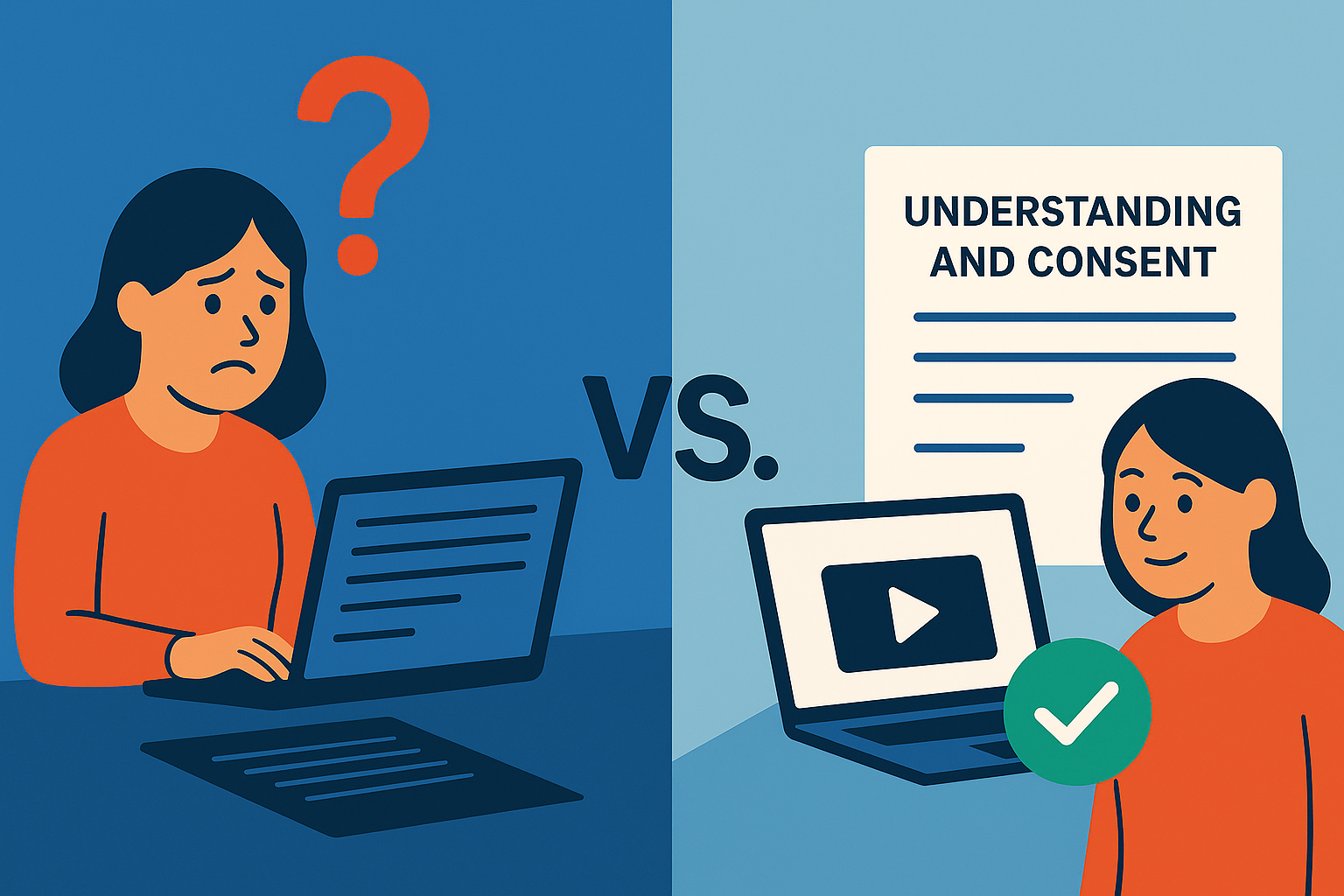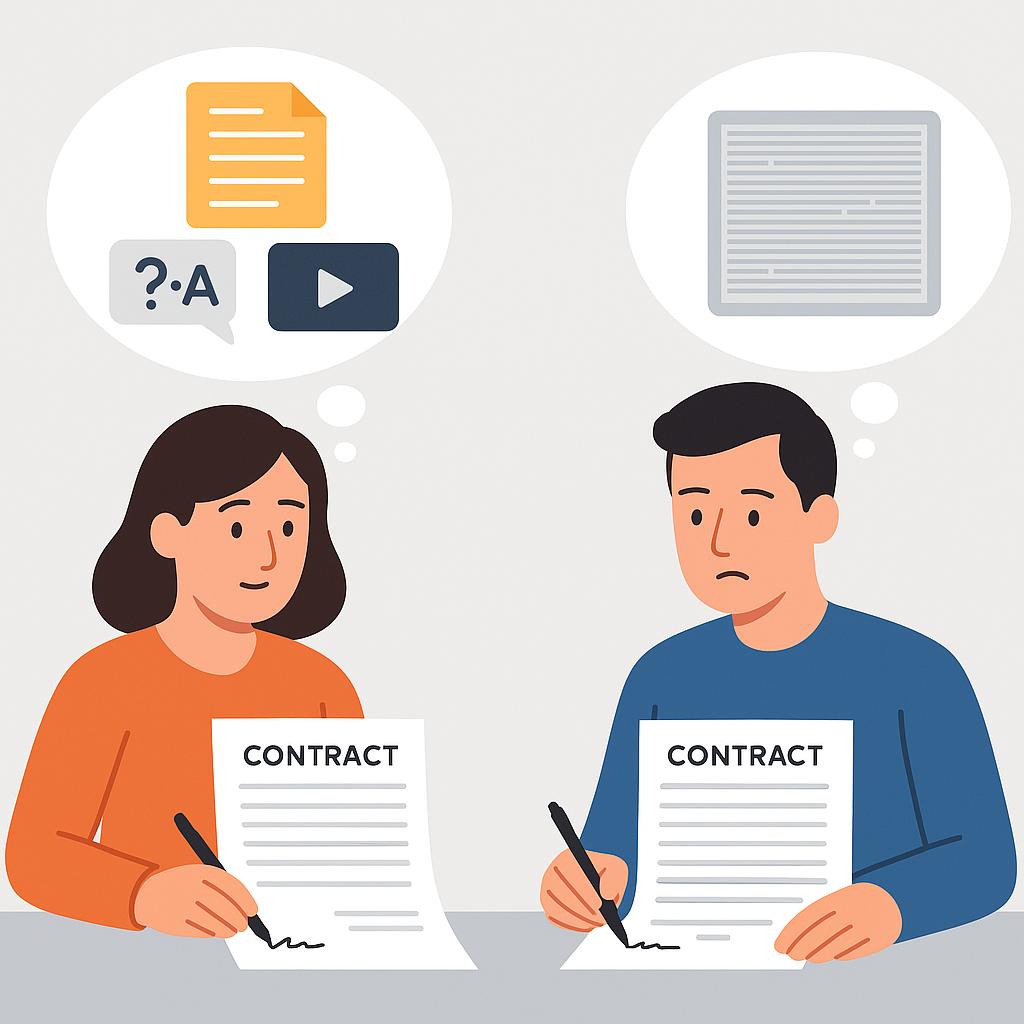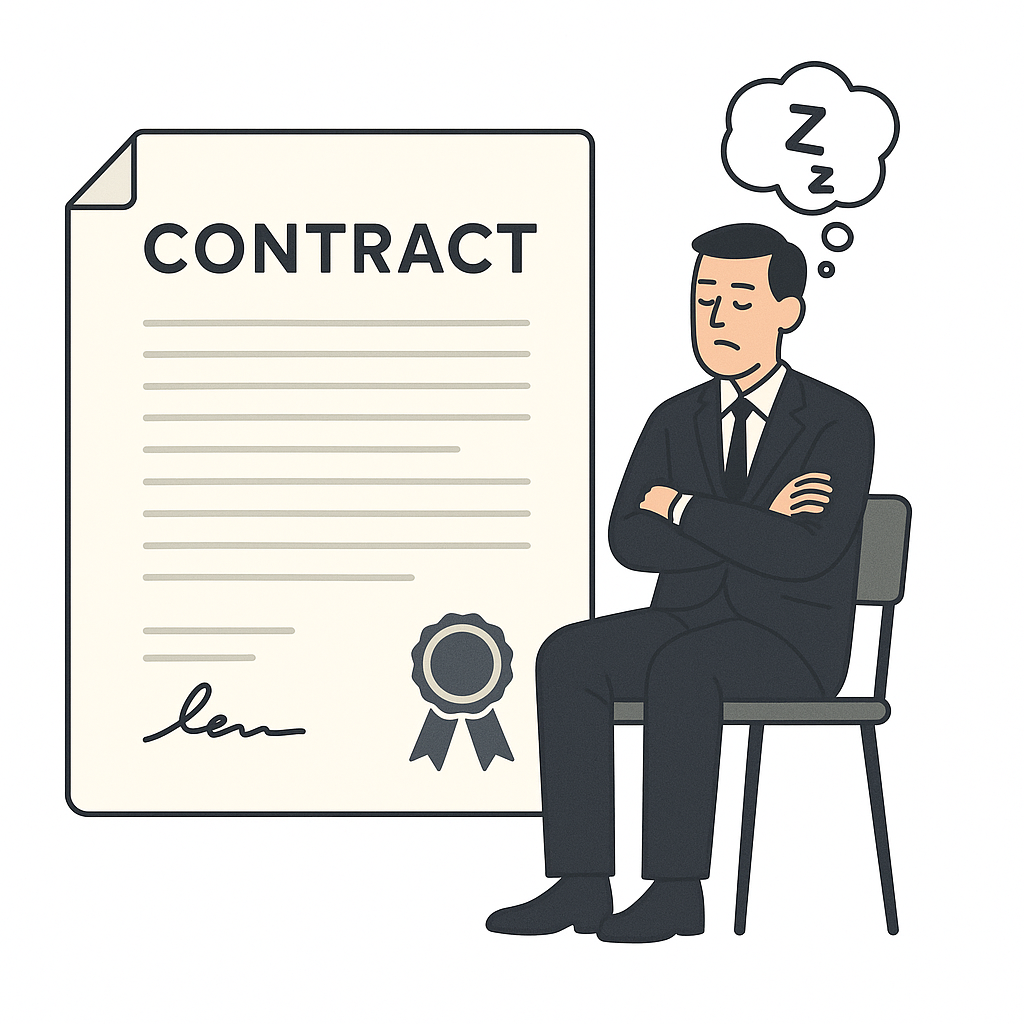For a long time, financial services firms have relied on signatures to prove customer agreement. Whether wet ink or digital, the assumption was that if a client signed a document, the job was done.
But the FCA’s Consumer Duty has changed that thinking. Under the new rules, it’s no longer enough to show that a customer received a document or clicked to sign it. You now need to prove that they understood it.
That shift changes the game for e-signature tools. If your signature process doesn’t go beyond formality and actually help customers understand what they’re signing, you could be falling short of FCA e-signature compliance.
This post explores what the FCA expects, where traditional signature tools miss the mark, and what firms can do to stay on the right side of the rules.
- Why e-signatures alone fall short of FCA signature rules
- Consumer Duty consent requires more than a signature
- The risks of using legacy e-signature platforms
- What FCA e-signature compliance looks like in practice
-
 i agree helps firms meet Consumer Duty consent standards
i agree helps firms meet Consumer Duty consent standards - Why FCA signature rules matter now more than ever
- Get help with FCA e-signature compliance
- Final thoughts on consumer duty consent and signature tools
Why e-signatures alone fall short of FCA signature rules
The FCA has made it clear that a signature is not enough. In the world of Consumer Duty, what matters is the outcome for the customer. Did they receive good information? Did they understand it? And did they make an informed decision?
Under the updated FCA signature rules, regulators now expect firms to:
- Present information in clear, accessible language
- Check that customers understand key facts before they consent
- Design communications to reduce the risk of harm
- Support vulnerable customers with additional formats or assistance
Traditional e-signature platforms were built for speed and documentation. They make it easy to sign something quickly, track IP addresses, and store PDFs in the cloud. But they don’t do anything to support comprehension or understanding.
If a customer signs a complex legal document in 10 seconds, that might look efficient on paper. But under the FCA’s expectations, it might raise a red flag.
Consumer Duty consent requires more than a signature
The concept of consumer duty consent is very different from the old definition of agreement.
In the past, getting a signed contract might have been enough to close the file. Now, the FCA expects firms to go further and ensure the customer’s consent was informed, clear and supported.
That means:
- The customer was given information in a way they could actually understand
- They had time to review it properly
- They were not pressured or confused during the process
- There is evidence that they engaged with the information before agreeing
A quick scroll-and-sign interaction on a PDF simply doesn’t provide that. If a customer complains later, a signature alone won’t protect you.
Firms need to demonstrate that they took reasonable steps to help the customer make a good decision. That’s the heart of consumer duty consent.
Read more about our legal and regulatory approach.
The risks of using legacy e-signature platforms
Most e-signature providers were never designed for regulatory compliance. They were built to move documents through a process quickly, not to help customers understand them.
This creates several risk areas:
- Long contracts with legal jargon that customers don’t read or can’t understand
- No way to confirm comprehension, just a final click to sign
- No support for vulnerable users, such as those with cognitive impairments or low literacy
- No insight into engagement, like how long the customer spent reading key terms
All of these issues expose firms to regulatory risk. If the FCA audits your consent process, will you be able to show that you delivered clear, understandable information and supported real understanding?
Firms that rely solely on legacy tools may struggle to answer yes to that question.
What FCA e-signature compliance looks like in practice
Meeting FCA e-signature compliance requirements means rethinking your signature journey from start to finish. It’s not just about putting a document in front of someone. It’s about designing an experience that leads to informed consent.
Key features of a compliant approach include:
- Clear summaries: Pulling out the most important terms and presenting them in plain language
- Layered content: Letting users explore more detail if they want, without being overwhelmed
- Accessible formats: Supporting audio, video, larger text, and translation where needed
- Engagement tracking: Recording how users interact with the information, not just when they sign
- Built-in confirmation steps: Asking customers to confirm that they understand, not just agree
This approach also supports firms when things go wrong. If a customer complains that they didn’t understand something, your audit trail shows not just that they signed, but that they were actively engaged in the process.
It’s a smarter and safer way to manage compliance.
 i agree helps firms meet Consumer Duty consent standards
i agree helps firms meet Consumer Duty consent standards
At  i agree, we built our platform to help regulated firms stay compliant with Consumer Duty from day one. Instead of focusing on documents and signatures, we focus on clarity, understanding and confirmation.
i agree, we built our platform to help regulated firms stay compliant with Consumer Duty from day one. Instead of focusing on documents and signatures, we focus on clarity, understanding and confirmation.
Here’s how we do it:
- Plain-English summaries.
Every agreement starts with a summary written in human language, not legal terms. We highlight what matters most, including fees, obligations and key dates. - Video explanations.
We convert the summary into a short video that explains the key points aloud. This supports users who prefer watching or listening over reading. - Confirmed understanding.
We ask users to confirm their understanding before they give consent. If they aren’t sure, we guide them back through the key points. - Support for accessibility.
Whether users need subtitles, screen reader support or simplified formats, we make sure information is available in ways they can process. - Evidence that proves engagement.
We don’t just log the moment someone gives consent. We record how long they spent reading, whether they watched the summary video, and how they moved through the content. This creates a rich, auditable trail.
By focusing on understanding rather than just signatures, we help firms meet the real goals of the Duty — and reduce the risk of future complaints.
Why FCA signature rules matter now more than ever
The FCA has made clear that the Consumer Duty is not just a guidance document. It is a framework they are actively using in reviews, audits and enforcement.
Firms that fail to adapt will find themselves exposed in areas like:
- Complaints handling
- Customer onboarding
- Product disclosures
- Fee explanations
- Vulnerable customer support
Relying on outdated e-signature systems is no longer a low-risk decision. The gap between what those tools provide and what the FCA expects is growing fast.
Firms that act now can get ahead of the risk. Those that wait may find themselves facing difficult conversations with the regulator — or worse, redress schemes, fines or loss of customer trust.
Get help with FCA e-signature compliance
If you are reviewing your current processes and want to make sure they meet the new standards, we can help.
You can explore our FAQs , read about our legal and regulatory approach, or dive into use cases for financial services.
Our goal is simple: to help your customers understand what they’re agreeing to, and to help you prove it.
Final thoughts on consumer duty consent and signature tools
The days of relying on a quick click and a PDF signature are over. The FCA expects more — and so should you.
Consumer duty consent means designing processes that help real people make real decisions with confidence. It means moving beyond documentation and towards understanding.
Whether you are in lending, insurance, wealth management or any other regulated space, the signature process you use today needs to support your compliance tomorrow.
If it doesn’t, now is the time to rethink it.




